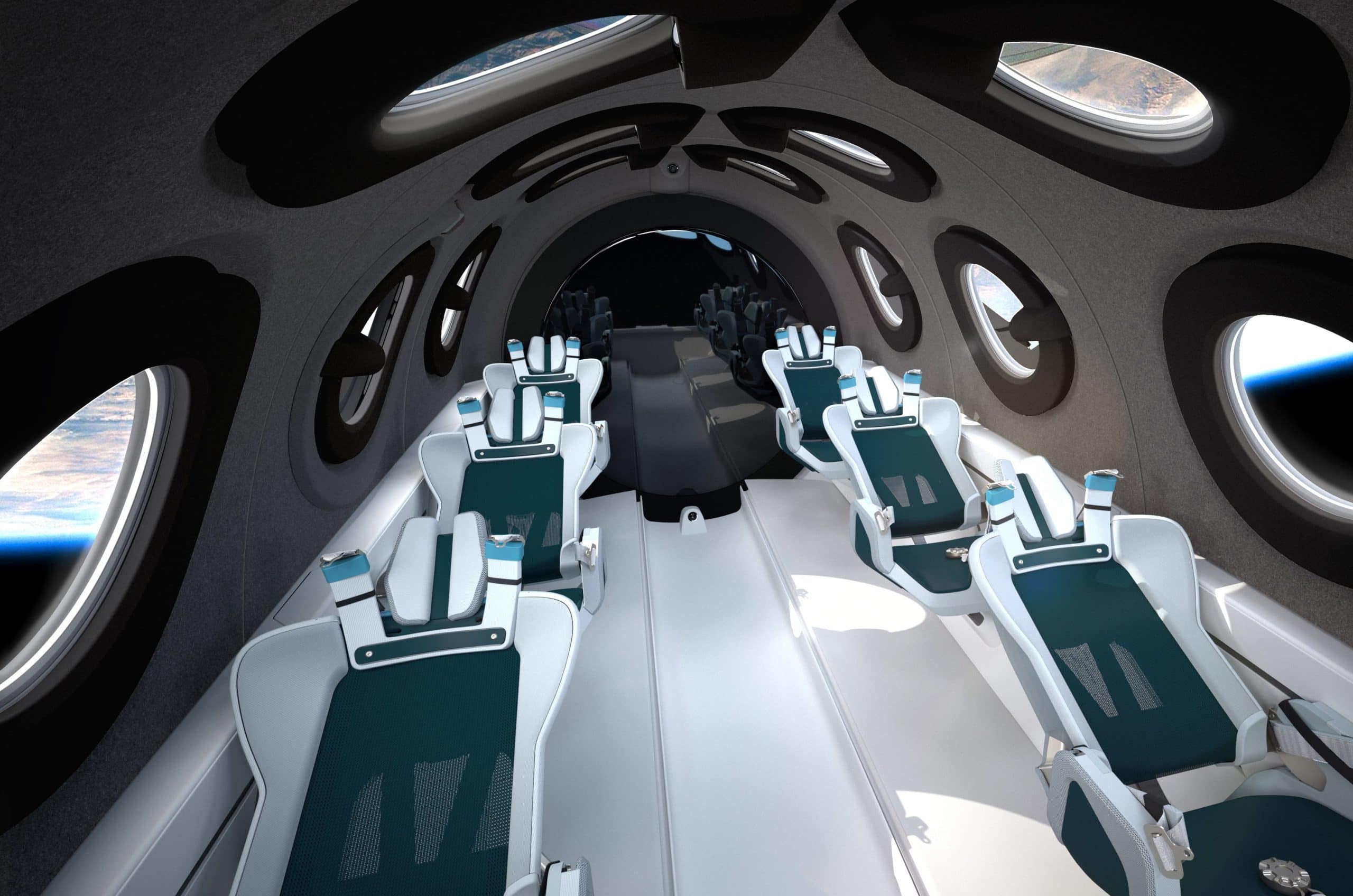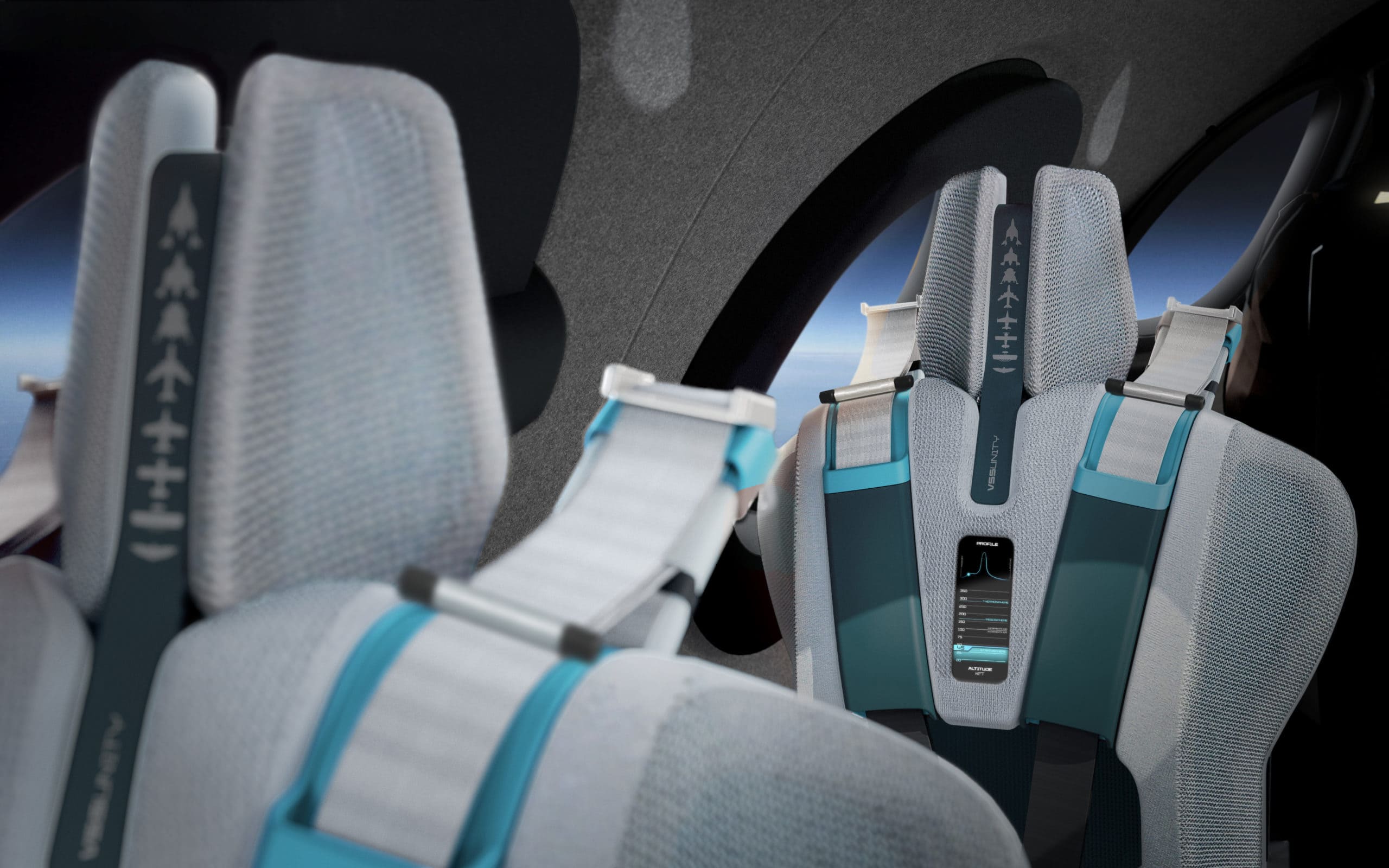Virgin Galactic Reveals SpaceShipTwo Cabin, With Ceiling Windows, Built-In Cameras and Seatback Displays
Share

As Virgin Galactic prepares for commercial service, the space tourism company has given aspiring astronauts a glimpse of what it will be like. Disney veteran Michael Colglazier recently assumed the role of Virgin Galactic CEO to ensure the experience, which will be centred around the view of Earth and the experience of weightlessness, is as magical as anticipated.
Virgin Galactic gave the public a first look at what the interior of its SpaceShipTwo cabin will look like when it begins operating spaceflights from New Mexico’s Spaceport America. The renderings were revealed today on YouTube (video below), after which an augmented reality app was launched for both Apple and Android users.
The design process was guided by input from a variety of experts including doctors, astronaut trainers, pilots, engineers and Virgin Galactic’s future astronaut customers. “The very first thing we did…was talk to our customers about their expectations for what they wanted when they went to space,” said George Whitesides, chief space officer, Virgin Galactic, during the YouTube reveal. “It was those expectations around the rocket ride, the weightlessness, the view of the Earth from space and the reception of their astronaut wings upon the conclusion of the journey, that were the key drivers behind our entire design process.”

The cabin features six passenger seats, which recline both for comfort – especially during launch and return, when g-forces are in effect – and to maximize cabin space during the zero-gravity portion of the trip, according to Jeremy Brown, design director, Virgin Galactic. Each seat is equipped with a seatback screen, but the in-flight entertainment will be different from what airline passengers are used to. The displays will show live flight data including speed, g-force and remaining boost time.

The seats were created using aluminum and carbon-fiber manufacturing techniques, and breathable fabric provided by Under Armour, which also developed the spacesuits that passengers will wear. Since SpaceShipTwo is meant to perform tourism as well as research functions, each seat can easily be replaced with equipment, Whitesides said.
A total of 17 windows (five for the pilots and 12 for passengers) perforate the cabin walls. Each one is bordered by foam that passengers can grasp, in order to get the best view while floating around the cabin during zero-g.
“We’ll turn [the mood lighting] off completely whilst you’re in space, to let Earth provide the ultimate beautiful lighting.” – Jeremy Brown, Virgin Galactic
The desire to capture and share the experience was top of mind for the design team, which incorporated 16 cameras into the cabin (in addition to those in the cockpit and mounted externally). The cabin also features a large mirror that allows passengers to see themselves hovering over their seats, without waiting for the camera footage.
Virgin aircraft are known for their mood lighting and this technology will also be present on SpaceShipTwo. “We work alongside several astronauts who tell us that space is deep black and Earth is extremely bright, giving us a natural light source on board. But we also know the importance of lighting in our environment and how we can use it to enhance your experience,” Brown said. “We use [multi-color LED] lighting functionally during boarding. We’ve also programmed it for different phases of the flight, using a calming color on your cruise up to release altitude and we can add more vibrancy through the energetic rocket boost phase. We’ll turn it off completely whilst you’re in space, to let Earth provide the ultimate beautiful lighting.”
Seymourpowell developed the color palette, which features golden metallics, blue hues and teal tones to evoke desert sands, celestial spaces and the ocean, respectively. The London-based design firm created a concept in 2016 for Airbus A380 first-class suites, called First Spaces.
[BREAKING] @virgingalactic's #SpaceShipTwo Unity interior will feature 6 passenger seats with digital seatback displays, 17 windows, 16 built-in cameras. Coverage of the reveal coming soon on https://t.co/nrsTwDlc8w. Full video: https://t.co/knPNKSMjjk #VirginGalactic pic.twitter.com/cRd9HCLHLV
— Kristina Velan (@kristinavelan) July 28, 2020
“It’s a big moment today … for anyone who has ever dreamt of flying to space including our … founder, Richard Branson,” said Michael Colglazier, who assumed the role of CEO of Virgin Galactic one week ago following 26 years at The Walt Disney Company, the final two of which he spent leading Disney Parks International as president and managing director.
Virgin Galactic was hoping to send Branson, who turned 70 this month, to space to celebrate the milestone and the company was on track to do so prior to the pandemic. Before becoming the first space tourism company on the New York Stock Exchange in October, the company told investors that commercial flights would begin in the first or second quarter of this year, setting a target for 16 flights in 2020.
The company has not announced a new timeline but is currently accepting $1,000 refundable deposits to join its Spacefarer community, which will be given priority when new tickets become available. 600 aspiring astronauts form what Virgin Galactic calls its Future Astronaut community, which has already secured seats on board SpaceShipTwo by paying significant deposits toward the $250,000 price tag for seats reserved before the company’s first test flight in December 2018. The company plans to charge more for the second round of seat sales.
Beth Moses, chief astronaut instructor, Virgin Galactic, was the first person to fly in the customer cabin of SpaceShipTwo, during the second test flight in February 2019. “We tested ways to get in and out of the seat, ways to improve the seat interfaces, translation aids, handling aids, how you move about the cabin,” she explained during the YouTube reveal. “[The cabin] both facilitates your movement … so you can get to any window or next to any person … while not distracting you from the view. The cabin interior will be successful when the … view of Earth from space is the star of the show, and the cabin is an almost invisible but perfect supporting act.”


